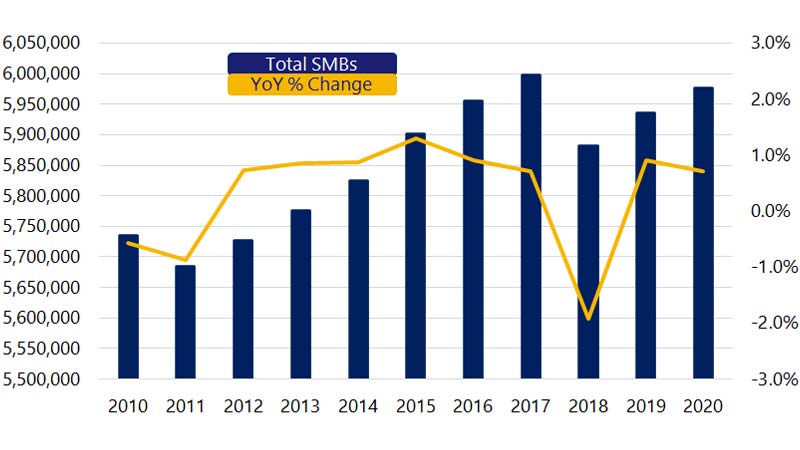The supply side
The COVID-19 pandemic interrupted the global supply chain in a way not seen in the modern era, producing the lowest inventory-to-sales ratio on record in March of this year.⁵ This major supply chain disruption continues to today in the U.S. At the same time, large-scale fiscal stimulus programs, vaccine deployments, and roll backs on COVID restrictions rapidly released pent-up consumer demand that took suppliers by surprise and exacerbated the problem. Labor shortages in the transportation industry further hampered U.S. supply chains, leading to a rapid rise in prices for both producers and consumers. This flowed through to the inputs many small businesses rely on. According to the September NFIB COVID-19 survey of small businesses, 90 percent of small businesses reported that supply chain disruptions had impacted their business, with half of all respondents saying that the impact was significant.⁶ According to the same survey, just over two-thirds of small businesses anticipated these disruptions to continue impacting their business for six months or more. The recent surge in inflation should stay with us well into 2022, which will compress margins going forward if businesses cannot implement solutions to drive further efficiencies and keep costs under control.
Beyond input price increases, small businesses have had to invest more resources to comply with protocols and consumer preferences around COVID-19 safety. These investments include PPE equipment, sanitizers, barriers in restaurants, masks and gloves. While the exact cost of these measures is hard to estimate, a Washington Post survey of attorneys general and financial departments across the U.S. found that consumers in 29 states had filed 510 complaints of coronavirus-related surcharges.⁷ Many more small businesses are likely to have increased prices without explicitly charging consumers for the added costs. Depending upon the type of small business, these costs could be quite onerous. Small grocery stores, for example, operate on very tight margins. According to a McKinsey report, the cost to small grocers to cover additional labor and cleaning products was estimated at 1 percent of their revenues.⁸ These costs add yet more hurdles for small businesses to overcome if they are to survive.
Labor is one of the biggest issues facing small businesses during this recovery. Two recent NFIB surveys illustrate this point, with nearly 10 percent of small businesses saying their biggest problem was the cost of labor,⁹ while two-thirds faced some kind of labor shortage and 27 percent reported a severe labor shortage.¹⁰ In response, 77 percent of small businesses said they increased wages to fill the open positions. Some of the current labor shortage is expected to subside following the expiration of enhanced unemployment insurance benefits; however, the lack of childcare options for many potential applicants and former small business employees is also preventing a return to normal staffing levels. The September NFIB COVID-19 survey found that 29 percent of small businesses have had at least one employee quit due to a lack of childcare options, and 18 percent have had difficulty hiring applicants due to childcare challenges. As long as the labor market remains this tight, small businesses will struggle to keep their doors open.
While many small businesses have considered increasing compensation or offering bonuses or other benefits to overcome the labor shortage, these measures only compound their existing costs related to inputs and COVID-19 compliance. Many small businesses have already increased prices (44 percent) or plan to increase prices (49 percent) to help offset the costs. But there is a limit to what they can do if they want to remain competitive with other small businesses or large businesses, which usually have the advantage of economies of scale¹¹ that small businesses do not have. Another path forward to minimize these costs by investing in labor and material saving technology. While this on its’ own should incentivize further innovations among small businesses, they are also feeling this pressure on the demand side.
